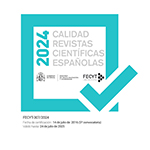Análisis cuantitativo de las revistas de América Latina y el Caribe indexadas en Web of Science (2021)
Resumen
El presente trabajo muestra un estudio cuantitativo de las revistas Latinoamericanas indexadas en la Web of Science, para 2021. El objetivo principal es analizar cuantitativamente la visibilidad e impacto de las revistas editadas en la región, incluidas en los núcleos de la Web of Science. Se aplicó una metodología de enfoque meta analítico con datos obtenidos del portal oficial de la Web of Science. Los datos fueron procesados mediante estadística multivariante y los resultados analizados a través de gráficas y clasificación de países por número de revistas y factor de impacto con árbol de clasificación-regresión. Los resultados indicaron que 6 países agrupan el 88,64% de revistas indexadas: Brasil, Colombia, Argentina, México, Chile y Venezuela. El núcleo con la mayor cantidad de revistas es ESCI con 60,28% del total, siendo Colombia el país con el mayor porcentaje respecto a su total con 80,0%. Los países con revistas con factores de impacto JCI mayores a la media de sus categorías (JCI > 1) fueron Brasil, Chile, Colombia, México y Venezuela. Los países de clasifican en 8 grupos, con Argentina, Brasil y Colombia como los de mayor importancia. El idioma de mayor uso es el español con 34,2% de las revistas, seguido por el inglés y el portugués. Se concluye que, en la región existe una cantidad baja de revistas indexadas en Web of Science y de pocos países, por lo que se debe impulsar la indexación de las revistas aumentando la calidad y sean ubicadas en los núcleos principales para que más países aumenten su presencia en la base de datos.
Descargas
Descarga artículo
Licencia
La Revista General de Información y Documentación, para fomentar el intercambio global del conocimiento, facilita el acceso sin restricciones a sus contenidos desde el momento de su publicación en la presente edición electrónica, y por eso es una revista de acceso abierto. Los originales publicados en esta revista son propiedad de la Universidad Complutense de Madrid y es obligatorio citar su procedencia en cualquier reproducción total o parcial. Todos los contenidos se distribuyen bajo una licencia de uso y distribución Creative Commons Reconocimiento 4.0 (CC BY 4.0). Esta circunstancia ha de hacerse constar expresamente de esta forma cuando sea necesario. Puede consultar la versión informativa y el texto legal de la licencia.











